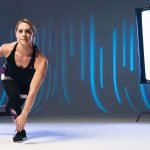Trainer Nicole Stuart is known for working with some of the biggest names—and most impressive physiques—in Hollywood. Actress and Fabletics co-founder Kate Hudson is a longtime client, and in the 18 years they’ve sweat together, Hudson has become a fitness guru in her own right. Anna Faris, Demi Moore, and Ashley Benson have also experienced Stuart’s Pilates-inspired method.
With a roster that impressive, you’d think Stuart’s advice would extend only to A-listers who work out as part of their jobs. But as it turns out, her advice isn’t exclusive to the fitness elite—not at all. Stuart shared her biggest fitness tips with UK-based health website Healthista, and they’re refreshingly real, honest, and doable.
Here are five of Stuart’s key tips for a balanced fitness routine that keeps you feeling strong, healthy, and on track with your goals.
1. Be real with yourself about how hard you’re working.
When it comes to reaching your health goals, holding yourself accountable is critical. “Be really honest with yourself about what you’re eating, what you’re doing [fitness-wise], and the type of lifestyle that you have,” Stuart told Healthista.
This means getting real with yourself about where you’re not quite meeting the goals you set for yourself, whether that’s how often you bring a healthy lunch to the office or how many times a week you fit in a workout. It’s a common trap to fall into—for example, maybe you like to think you hit the gym four days a week, but in reality, it’s only once or twice.
Once you can identify where you’d like to improve, that’s where the motivation comes in to actually do it. “Sometimes if I’ve been working all day, I don’t feel like working out,” says Stuart. “I’ll start to hear that voice trying to talk me out of it… but it’s during those times you really have to show up.”
2. Don’t deprive yourself.
A nutritious eating plan and a consistent, well-rounded fitness routine are both important for overall health, but that doesn’t mean there’s no room to treat yourself—long-term, depriving yourself of the foods you love can often lead to bingeing later. So if you really want some ice cream, go for it, Stuart says. The key is moderation. If it’s tough for you to stop at just a little, Stuart suggests buying single servings of your favorites (like buying one cookie instead of a package). “This is where being honest with yourself comes into play again,” Stuart says. “If you know you’re going to eat the whole box then just buy one.”
As for your workouts, yes, it’s important to push yourself to get up and move if you haven’t sweat in a week, says Stuart. But regular rest days are actually critical to seeing fitness results. Muscles get stronger as they rebuild, and skipping rest days can lead to overtraining (which can put you even further from your goals).
3. Understand that “movie bodies” aren’t built by sustainable fitness habits.
Here’s the deal with the bodies you see on the big screen: Often, they’re the result of dedicated, hardcore training plans and strict diets that weren’t designed to be maintained for long periods of time. Stuart trained Faris for House Bunny, and she wasn’t in incredible shape by accident—Faris ate a reduced-calorie diet and increased the frequency and length of her workouts leading up to filming.
This routine was designed for the movie, though—not for the rest of her life. “We were on a strict program for about two to three months and she was highly motivated,” says Stuart. This type of extreme plan can achieve short-term goals quickly, but it’s not sustainable. Over time, low-calorie diets can zap your energy and leave you “hangry,” and they can also contribute to weight-loss plateaus, if weight loss a goal of yours. Working out too often can mess with your immune system, your mood, and your sleep, and can also make you more prone to pain and injury.
4. Embrace fitness videos and apps to get moving.
These days, getting active doesn’t require a gym. There are countless fitness apps and YouTube videos that make fitness accessible for everyone, says Stuart—which also means there are no excuses. Whether you’ve got 10 minutes or 30, you’re looking for cardio or strength, or you want to target your upper or lower body, there’s a free workout out there to try.
Plus, many of them require no equipment, so you can squeeze in a quick workout anytime, anywhere. (Try this 20-minute HIIT workout you can do anywhere, or these 13 no-equipment leg exercises you can do at home.)
5. Don’t just work out for the physical benefits—do it for the mental ones, too.
Stuart opened up about how transformative exercise has not only been to her physical health, but also her mental health. “I was at a point in my 20s when I was seriously depressed and I would go running up in the canyons. It didn’t solve all my problems, but just getting fresh air and walking up the mountains made me feel like everything wasn’t as bad as I thought. I suddenly had a way of managing it and dealing with it,” Stuart tells Healthista. “For me, working out has always been more mental than physical, and it’s really helped me through times of stress.”
Research backs up the mental health benefits of exercise, adding to a long list of reasons to incorporate fitness into your life—however it works for you.
Source:-self.c










